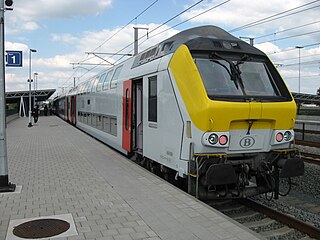
Belgium has an extensive rail network. It is a member of the International Union of Railways (UIC). The UIC Country Code for Belgium is 88.
Push–pull is a configuration for locomotive-hauled trains, allowing them to be driven from either end of the train, whether having a locomotive at each end or not.
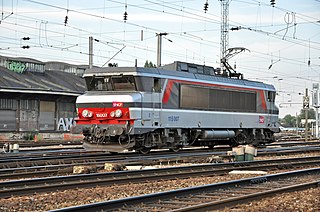
The SNCF class BB 15000 is a class of 25 kV 50 Hz electric locomotives built by Alstom and MTE between 1971 and 1978. Initially 65 locomotives strong, the class was widely deployed on the whole French 25 kV network before being replaced by TGV trains when the LGV Est went into service in 2007.
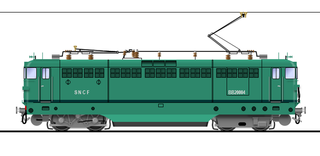
The SNCF class BB 20004 locomotive was a dual-voltage test-bed locomotive transformed from the damaged BB16540 in 1959. After the end of its test period in 1969 it was reinstated with its original equipment under its original number BB16540.
The SNCF class BB 20005 locomotive was a prototype locomotive of the BB25150/BB25200 series, transformed from the damaged BB16028 in 1961. After the end of its test period in 1975 it was reinstated with its original equipment under its original number BB16028.

Class 11 is part of the large 1980s family of 144 electric locomotives. The family was made up of Classes 11 (12), 12 (12), 21 (60) and 27 (60). Classes 11, 12 and 21 were nearly twice as powerful as Classes 22, 23 and 25 while Class 27 was more than twice as powerful as these 1950s locomotives. This family was heavily influenced by the Class 20² from the mid-1970s. They were very reliable because of the trial and error development of their predecessor. This family came into service with M4 and M5 coaching stock and the AM 80 and AM 86 series of EMUs. This generation was a major modernization of the NMBS/SNCB even if the older M2 coaching stock remained active for more than a decade before being replaced. The only real difference between a Class 11 and a Class 21 was the Class 11 had a transformer inside to allow working under both 3000 V DC in Belgium and 1500 V DC plus Dutch signalling and train protection for working in Holland. Externally they were identical to Classes 12 and 21 aside from the livery and a few minor details.

Class 27 were the first of the Belgian Railways' large 1980s family of 144 electric locomotives. The family was made up of Classes 11 (12), 12 (12), 21 (60) and 27 (60). Classes 11, 12 and 21 were nearly twice as powerful as the preceding classes 22, 23 and 25. Class 27 was more than twice as powerful as these 1950s locomotives. The family was heavily influenced by the Class 202 locomotives built in the mid 1970s. They are very reliable because of the trial and error development of their predecessors. This family came into service with M4 and M5 coaching stock and the AM 80 and AM 86 series of EMUs. This generation was a major modernisation even if the older M2 coaching stock remained active for more than a decade. These four sister classes are visually identical except for a few minor details. Class 11's livery was specific to the Benelux service, which they operated for most of their service lives.
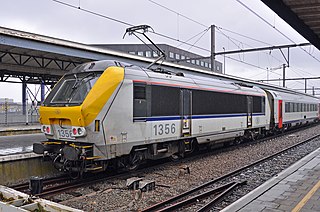
The Class 13 are a type of mixed use 200 km/h (124 mph) multivoltage electric locomotive of type Traxis designed by Alstom in the late 1990s for the Belgian and Luxembourgish railways.
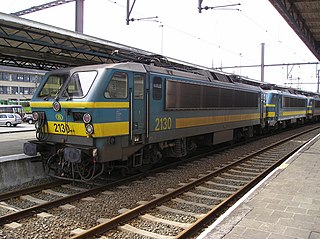
SNCB Class 21 is part of the large 1980s family of 144 electric locomotives. The family was made up of Classes 11 (12), 12 (12), 21 (60) and 27 (60). Classes 11, 12 and 21 were nearly twice as powerful as Classes 22, 23 and 25 while Class 27 was more than twice as powerful as the 1950s locomotives. This family was heavily influenced by the Class 20 from the mid-1970s. The 1980s locomotives were very reliable because of the trial and error development of their predecessor. This family came into service with M4 and M5 coaching stock and the AM 80 and AM 86 series of EMUs. This generation was a major modernization of the SNCB even if the older M2 coaching stock remained active for more than a decade before being replaced. These four sister classes are visually identical except for a few minor details. Class 11's bordeaux and yellow livery is specific to the Benelux service which they powered for most of their service lives.

Class 20 is a class of electric locomotives formerly operated by SNCB, the national railway of Belgium.

SNCB Class 22 Locomotives were owned by the National Railway Company of Belgium, also known as Nationale Maatschappij der Belgische Spoorwegen or Société Nationale des Chemins de fer Belges, the Belgian national railway operator.

Class 23 locomotives were part of the 1950s generation of SNCB electric locomotives that included Types 122, 123, 125, and 140 built between 1953 and 1961. There were 50 Series 122, 83 Series 123, 16 Series 125 and 6 Series 140 for a total of 155. They were seen across Belgium on passenger and freight trains until they were retired in 2012. Class 23 was later fitted for multiple working, and were often found in pairs. There was no difference in power between the classes as they all used the same traction motors and control equipment.

Class 25 locomotives were part of the 1950s generation of SNCB electric locomotives that included Types 122, 123, 125, and 140 built between 1953 and 1961. There were 50 Series 122, 83 Series 123, 16 Series 125 and 6 Series 140 for a total of 155 locomotives. They were seen across Belgium on passenger and freight trains until they were retired in 2012. Class 23 was later fitted for multiple working, and were often found in pairs. There was no difference in power between the classes as they all used the same traction motors and control equipment.

NMBS/SNCB Class 26 are single voltage locomotives that were designed as freight locomotives. They later started working on passenger trains as the electrification was expanded. A batch of five prototypes were delivered in 1964 as Type 126, numbered 126.001-126.005. 20 more were ordered around 1968, to be numbered 126.101-126.120. The final 15 arrived in 1971 and just missed getting six figure fleet numbers, carrying the numbers 2621-2635 from the factory. Actual original numbering turned out to be 126.001-126.005, 126.101-126.120 and 2621-2635. They had nothing in common with earlier Types 122, 123, 125, and 140.

The EuroSprinter family of electric locomotives is a modular concept of locomotives for the European market built by Siemens Mobility. The internal Siemens product name is ES 64, with ES for EuroSprinter and the number 64 indicating the 6,400 kW power at rail.

The NMBS/SNCB Class 28 number series has been brought back into use for 43 Bombardier TRAXX locomotives which have been hired from Angel Trains Cargo for use with B-Cargo, the freight division of NMBS/SNCB, since renamed Lineas. They are numbered in two series - they carry their original numbers, E186 123 to E186 125, and E186 196 to E186 220, and have also been numbered into the SNCB number series, 2801 to 2843.

SNCB's Class 12 locomotives were dual-voltage electric lomotives built for cross-border service into France. They were based on the single-voltage Class 21 locomotives. They are part of the large 1980s family of 144 electric locomotives.

The SNCB/NMBS HLE 18 are a series of four axle Bo′Bo′ multivoltage electric Siemens EuroSprinter locomotives ordered in two batches of sixty in 2006 and 2008.
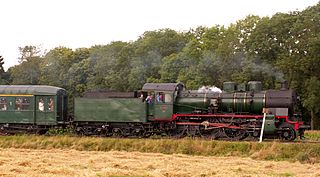
Patrimoine Ferroviaire et Tourisme(in French) (PFT) are a society dedicated to the preservation of Belgian railway heritage. They cover a number of aspects of railway enthusiasm, operating charter trains, maintaining heritage locomotives and operating a museum at Saint-Ghislain.

The NS Class 186 is a type of B-B electric locomotive built by Bombardier Transportation between 2006 and 2014. It is a member of the Bombardier TRAXX family of locomotives, the Bombardier TRAXX F140 MS2 variant.


















